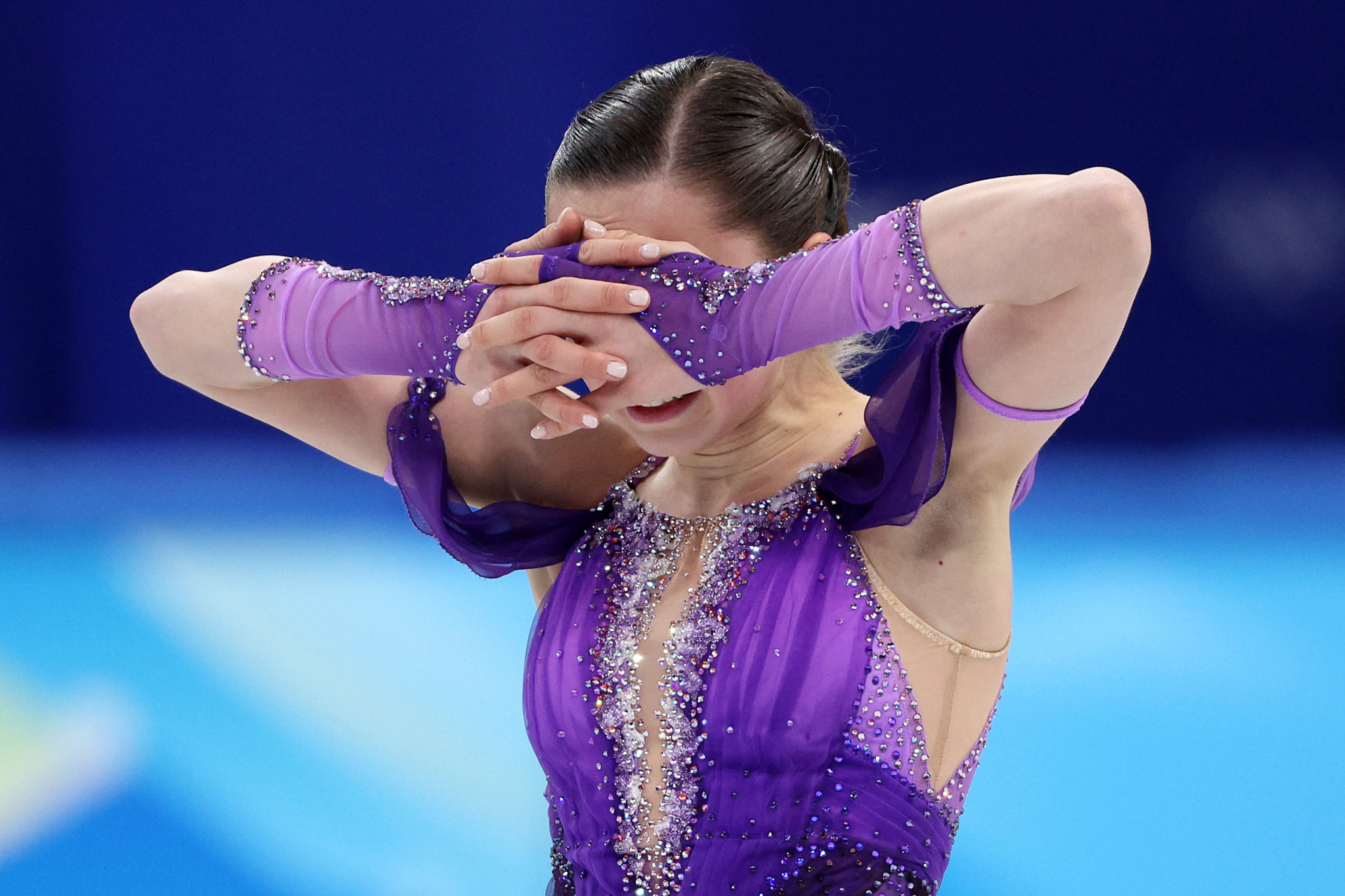Talented, trapped and - ultimately - tearful, 15-year-old Kamila Valieva today failed to reach a medal position in the women’s figure skating at the Beijing 2022 Winter Olympics.
The "asterisk" hanging over her performance appeared to have exerted a malign power.
Despite arriving at the final programme in the gold-medal position, the Russian youngster tumbled down the rankings, literally, as she made a series of falls. It was painful to witness.
In a situation that was not, ultimately, of her making, Valieva was operating under the pressure of worldwide scrutiny following the decision by the Court of Arbitration for Sport (CAS) to allow her to compete despite a sample she had provided on December 25 showing up as positive for the banned blood booster trimetazidine.
The positive result only emerged on February 8, the day after Valieva had played a key part in winning the team event for the Russian Olympic Committee, and her provisional suspension was lifted on appeal by the Russian Anti-Doping Agency on February 9.
In choosing not to re-apply the provisional suspension, CAS ruled that the delay in the sample finding coming to light had "infringed upon the athletes’ ability to establish certain legal requirements for her benefit", and that preventing her from continuing to compete "would cause her irreparable harm in these circumstances."
And so Valieva was freed to compete - under an intolerable mental burden as the final ruling over whether she had committed an offence or not was effectively pushed down the line.
In the wake of the CAS ruling the International Olympic Committee (IOC) - who with the World Anti-Doping Agency and the International Skating Union had appealed unsuccessfully against the lifting of the suspension - put its own parentheses around the event.
Having previously confirmed that no medal ceremonies would take place for the team event in the interim, the IOC announced that the result of the women’s individual figure skating competition would be provisional should Valieva, who had been a strong favourite, finish in the top three.

On the eve of today’s final programme, the IOC spokesperson Mark Adams said: "There will be asterisks against the results tomorrow because they will be preliminary pending further investigation."
This, then, the latest baleful example of the multi-purpose asterisk that in recent years has questioned, checked and qualified so many sporting efforts and records. It is certainly a powerful grammatical symbol. Ironically for Valieva, the word derives from the Greek asteriskos, meaning "little star".
Applying an asterisk to something implies that further information about it is necessary for a full understanding.
While the IOC may have been explicit about its asterisk in relation to the women's figure skating in Beijing, the mechanism is usually one where something is widely acknowledged or generally understood. The asterisk becomes, effectively, a raised eyebrow.
Sometimes this is merely a mechanical manifestation. At the Rio 2016 Olympics, for example, China’s women had a place in the final of the 4x100 metres with an effective asterisk. As the slowest of the qualifiers, they faced ejection if the United States, who were deemed to have been obstructed by the hosts during a baton change, managed to better their time in a solo time trial.
The United States duly did so and went on to take the gold medal.
It is also possible in some circumstances for athletes ruled to have false-started to run under an asterisk - formally, "under protest" - until final deliberation can be made. They risk having an inspired effort retrospectively disqualified, but it is usually seen as a gamble worth taking.
Staying with athletics, there are particular markers that qualify some performances, such as "A" denoting one achieved at altitude, or "W" to show it had benefited from a following wind of more than two metres per second, the maximum allowable for records purposes.
But an asterisk is generally understood alongside certain athletic marks. One such relates to the women's world 100, record of 10.49sec that has stood to the late Florence Griffith-Joyner since 1988.
Griiffith-Joyner’s late improvements, and the sudden end to her career, have roused suspicions in many quarters regarding doping - although no evidence of this was ever produced. There was also a strong body of opinion that the wind reading during her effort at the US Olympic trials in Indianapolis had been invalidated by an official, wittingly or unwittingly, standing too close to a gauge.
Meanwhile baseball, hit by a series of doping scandals, became so beset by records compromised by suspicions - or confirmations - of drug misuse that the term "asterisk" had become a widely known and used indicator of suspicious statistics.
So much so that in 2011 the United States Olympic Committee and the Ad Council launched an anti-steroid campaign aimed at teenagers called "Play Asterisk Free", enjoining them: Don’t Be An Asterisk.

Baseball has also provided one of the most widely-known instances of the use of a qualifying asterisk with regard to a big statistic.
In 1961, the New York Yankees’ Roger Maris broke one of baseball’s most celebrated records, scoring 61 home runs in a season to eclipse Babe Ruth’s legendary 1927 mark of 60, with the last of them coming in his last match.
But Maris set his record in the newly-extended 162-game season, whereas Ruth had operated within the previously standard number of 154 games.
In the middle of the season, baseball commissioner Ford Frick - who happened to be a friend of Ruth’s - announced that unless Ruth's record was broken in the first 154 games of the season, the new record should be shown separately in the "record books", with some "distinctive mark" next to it indicating it had been done in a 162-game season.
The actual suggestion of an asterisk being employed came from New York Daily News sportswriter Dick Young.
Maris received death threats as he closed in on Ruth’s record, and received police protection. It was reported that his stress was so great that clumps of his hair fell out.
The asterisk however remained more of an urban myth for years afterwards, as it was never officially adopted and all the main baseball record-keepers listed him as the single-season record-holder.
Similar asterisk-like conversations have been had in English football with regard to classifying teams who achieved the double of league and cup victories.
Preston North End were the first to achieve this distinction as they finished 1888-1889 as FA Cup winners and Football League champions. Aston Villa were the next double winners, in season 1896-1897, but there was a long wait for the third team on the list, with Tottenham Hotspur matching them in the 1960-1961 season.
Asterisk alert, however. It is pointed out by troubled statisticians that Preston’s league success involved 22 games. Villa had to play 30 games. And Spurs played 42 First Division games in their double-winning season.
So it has gone on, with some administering belated and, arguably, entirely unjustified asterisks to the earlier performances. What else were these teams expected to do?

In the world of tennis, the list of winners of the gentleman’s singles at the annual Wimbledon Championships is divided into amateur and then professional winners, with the cross-over point occurring between 1967 and 1968.
But five years into the professional tournaments came one which has forever after had its own invisible “asterisk”.
The 1973 men’s singles tournament was boycotted by 81 of the top Association of Tennis Professionals players, including the 1972 champion Stan Smith of the US - an action in support of the suspension in May 1973 of Yugoslavia's top player Nikola Pilić, whose national association claimed he had refused to play for them in a Davis Cup tie.
Twelve of the original 16 men's seeds withdrew, which meant the presence of many qualifiers and lucky losers, with the trophy eventually being lifted by Czech player Jan Kodeš.
For some, the uniquely challenging COVID-19 circumstances of 2020 brought the asterisk trundling out into the light once again.
Speaking to USA Today about the destination of the 2020 National Basketball Association (NBA) title, the game's legend Shaquille O’Neal said: "Any team that gets it done this year, there’s going to be an asterisk on that championship."
And after Miami Heat had lost to the Los Angeles Lakers in the 2020 NBA Finals, Miami President Pat Riley also landed firmly on that familiar territory, claiming - unjustly according to many - "There will always be that asterisk."
In sporting terms, the asterisk can be the equivalent of Treasure Island’s "Black Spot". As today’s traumatic proceedings at Beijing’s Capital Indoor Stadium demonstrate…

